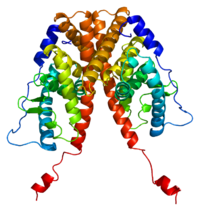
Photo from wikipedia
Abstract Objective: Several studies evaluated the relationship between estrogen receptor (ER) polymorphisms and the outcomes of controlled ovulation hyperstimulation (COH). However, the results remained obscure. The objective of this study… Click to show full abstract
Abstract Objective: Several studies evaluated the relationship between estrogen receptor (ER) polymorphisms and the outcomes of controlled ovulation hyperstimulation (COH). However, the results remained obscure. The objective of this study was to perform a meta-analysis to investigate the links between ER polymorphisms and COH outcomes.Methods: Eligible studies were identified from the following electronic databases: PubMed, Embase and the Chinese CNKI till Nov. 2021. The odds ratio (OR) and 95% confidence intervals (CIs) for dichotomous data and the weighted mean difference (WMD) with 95% confidence intervals (CIs) for continuous variables were used to calculate correlations between ER polymorphisms and COH outcomes. Based on the inclusion and exclusion criteria, a total of thirteen papers were eventually enrolled in the current meta-analysis.Results: The following were the key findings of this meta-analysis: (1) PvuII polymorphism had a significant relationship with IVF pregnancy outcome in all models, except the recessive model(CC VS TT: OR, 5.51, 95% CI, 1.13,26.84; CC + CT VS TT: OR, 3.73, 95% CI, 1.21,11.57; CT VS TT: OR, 3.19, 95% CI, 1.11,9.16;C VS T: OR, 2.19, 95% CI, 1.15, 4.19), with large or extreme heterogeneity; (2) XbaI polymorphism had a significant association with IVF risk in heterozygous and dominant models(AG VS GG: OR, 0.27, 95% CI, 0.12,0.61; AAAG VS GG: OR, 0.27, 95% CI, 0.12,0.59), with no heterogeneity; (3) (TA)n polymorphism was linked with IVF risk in the homozygous and recessive models(LL VS SS:OR = 3.74, 95%CI = 1.53,9.12;LL VS LS + SS:OR = 2.75, 95%CI = 1.18, 6.38), with no heterogeneity; (4) for Alul polymorphism and its association with POR risk, significant relationship was observed in the recessive model(AA VS AG + GG:OR = 2.27, 95%CI = 1.46, 3.54), with no heterogeneity;(5) PvuII T/C mutation did not predict the follicle number, oocyte number, ratio of follicles to oocytes and the risk of IVF;(6) for XbaI polymorphism and pregnancy outcome of IVF, no significant association was observed under all models; and (7) RsaI polymorphism does not increase the risk of POR under all models.Conclusion: In summary, our meta-analysis found evidence supporting that PvuII polymorphism may serve as a marker in predicting pregnancy rate in IVF-ET, XbaI and (TA)n polymorphisms may be related with infertility, and Alul polymorphism may predict the poor ovarian response to COH. More well-designed investigations are warranted to corroborate these findings.
Journal Title: Gynecological Endocrinology
Year Published: 2022
Link to full text (if available)
Share on Social Media: Sign Up to like & get
recommendations!